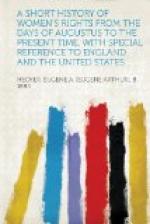At the present moment the cause of woman suffrage in England is being furthered chiefly by two organizations which differ in methods. The National Union of Women’s Suffrage Societies has adopted the “constitutional” or peaceful policy; but the National Women’s Social and Political Union is “militant” and coercive.
SOURCES
I. The English Statutes. Published by Authority during the Various Reigns.
II. Studies in History and Jurisprudence: by James Bryce. Oxford University Press, 1901. Pages 782-859 on “Marriage and Divorce.”
III. History of English Law: by Frederick Pollock and Frederic Maitland. 2 vols. Cambridge University Press, 1898—second edition.
IV. Commentaries on the Laws of England: by Sir William Blackstone. With notes selected from the editions of Archbold, Christian, Coleridge, etc., and additional notes by George Sharswood, of the University of Pennsylvania. 2 vols. Philadelphia, 1860—Childs and Peterson, 602 Arch Street.
V. A History of Matrimonial Institutions, chiefly in England and the United States: by George Elliott Howard. 4 vols. The University of Chicago Press, 1904.
VI. Social England: edited by H.D. Traill. 6 vols. G.P. Putnam’s Sons, 1901.
VII. Social Life in the Reign of Queen Anne, taken from original sources: by John Ashton. London, Chatto and Windus, 1897.
VIII. The Renaissance of Girls’ Education in England: by Alice Zimmern. London, A.D. Innes and Co., 1898.
IX. Progress in Women’s Education in the British Empire: edited by the Countess of Warwick. Being the Report of the Education Section, Victorian Era Exhibition, 1897. Longmans, Green, & Co., 1898.
X. Current Literature from the Earliest Times to the Present Day, references to which are noted as they occur.
NOTES:
[393] If a woman sentenced to execution declared she was pregnant, a jury of twelve matrons could be appointed on a writ de venire inspiciendo to determine the truth of the matter; for she could not be executed if the infant was alive in the womb. The same jury determined the case of a widow who feigned herself with child in order to exclude the next heir and when she was suspected of trying to palm off a supposititious birth. But from all other jury duties women have always been excluded “on account of the weakness of the sex”—propter defectum sexus.




